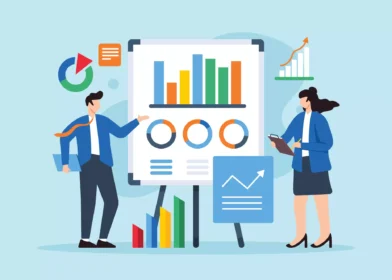The Role of Predictive Analytics in Sales Enablement
Sales teams are under pressure to deliver results faster, convert smarter, and operate more efficiently. The key to achieving this? Data—and more specifically, predictive analytics.
Predictive analytics transforms raw data into forward-looking insights, helping organizations identify high-quality leads, forecast buyer behavior, and align sales strategies with real-time market conditions. With the right data tools in place, sales enablement becomes less about reacting to trends and more about shaping them. In this blog, we’ll explore how predictive analytics supports smarter selling, how actionable insights are developed, and how data providers like Enformion empower sales teams with the intelligence they need to outperform the competition.
What Are Predictive Analytics?
Predictive analytics is the practice of using current and historical data—combined with statistical modeling, machine learning, and data mining techniques—to make informed predictions about future events. Rather than simply describing what has happened (descriptive analytics) or explaining why it happened (diagnostic analytics), predictive analytics goes a step further: it tells you what is likely to happen next.
In the context of modern business, predictive analytics is used across departments—from finance to operations to customer service—to improve decision-making and operational efficiency. But in sales, it has become a true game-changer. For sales teams, predictive analytics unlocks the ability to:
- Score and prioritize leads based on conversion likelihood
- Predict customer churn before it happens
- Forecast revenue pipelines with increased accuracy
- Refine outreach timing and channel selection
- Align messaging with likely buyer behavior and preferences
These models are trained on vast amounts of data—including historical purchase behavior, engagement signals (like email opens and website visits), firmographic and demographic data, and even third-party data sources. The goal is to identify patterns in this data that correlate strongly with desired outcomes, such as a closed sale or a high customer lifetime value.
For example, a predictive model might determine that leads from a certain industry, with specific job titles, who engage with product demo content within the first week of contact, are 70% more likely to convert. Armed with this insight, sales teams can focus their efforts on high-intent prospects and reduce time spent on leads less likely to yield results.
This ability to forecast and prioritize doesn’t just improve efficiency—it transforms strategy. Instead of relying on gut instincts or outdated scoring methods, predictive analytics provides a reliable, scalable way to guide sales activities with data-backed confidence.
When integrated with CRM platforms, sales enablement tools, or marketing automation systems, predictive analytics becomes a dynamic part of the sales engine—fueling proactive outreach, reducing wasted effort, and ultimately driving more consistent, measurable results.
How Predictive Models Enhance Sales Processes
Predictive models are the engine that powers intelligent sales strategies, helping businesses move away from one-size-fits-all approaches and toward finely tuned, data-driven decision-making. By analyzing patterns in historical and real-time data, these models uncover insights that improve how sales teams identify, engage, and convert prospects. When predictive analytics is built into the sales enablement process, it drives efficiency, precision, and ultimately, higher performance across the pipeline. Here’s how predictive models provide tangible value throughout the sales cycle:
Lead Prioritization: Not all leads are created equal. Predictive lead scoring uses data from various sources—such as web behavior, social media activity, email engagement, firmographics, and previous purchase history—to determine which leads are most likely to convert. This helps sales teams prioritize their outreach based on actual conversion potential, not just gut feeling or surface-level criteria.
Instead of sifting through hundreds of cold leads, reps can focus their time on prospects who show the strongest signs of interest or buying intent. This boosts productivity and ensures that high-potential opportunities don’t slip through the cracks.
Forecasting Accuracy: Sales forecasting has traditionally been plagued by human bias and incomplete data. Predictive models improve forecasting by analyzing historical sales trends, pipeline velocity, deal size, and win/loss ratios to produce more reliable projections. These insights help sales managers make smarter decisions about hiring, budgeting, and inventory planning. With more accurate forecasting, leadership teams can identify revenue risks earlier, set more realistic targets, and align resources with expected demand.
Shortened Sales Cycles: Predictive analytics gives sales reps a clearer picture of where each lead stands in the buyer journey. With this visibility, they can time their outreach for maximum impact—engaging when the buyer is most receptive and ready to move forward.
For example, if a model indicates that leads who download a pricing guide typically convert within 10 days, a rep can follow up quickly with tailored content or a demo offer to speed up the process. By aligning actions with buyer signals, reps can eliminate delays, overcome objections sooner, and close deals faster.
Improved Personalization: Modern buyers expect personalized experiences. Predictive models help deliver this by recommending tailored messaging, product suggestions, and outreach channels based on the buyer’s behavior and preferences. Rather than generic emails or scripted calls, reps can deliver communications that resonate with the individual’s specific challenges and interests.
Actionable Insights
Predictive analytics uncovers patterns, trends, and potential future outcomes—but actionable insights are what transform those findings into measurable business results. While predictive models answer the question, “What might happen?”, actionable insights address, “What should we do about it?” They distill vast, complex data sets into clear, prioritized recommendations that sales and marketing teams can put into practice immediately.
These insights go far beyond simple observations. They merge predictive outputs with contextual business understanding, customer behavior data, and operational considerations to provide strategies that can be directly executed. The difference is subtle but critical—raw predictions inform; actionable insights guide.
For instance, a predictive model might reveal that a certain industry segment has a higher likelihood of conversion. An actionable insight would refine this finding into a precise plan—identifying which decision-makers to target, what messaging is most likely to resonate, and the optimal timing and channels for outreach. This clarity enables sales and marketing teams to operate with confidence and efficiency. The value of actionable insights lies in their ability to:
- Prioritize opportunities so teams focus on the highest-impact prospects
- Optimize engagement strategies based on proven behavioral patterns
- Enable personalization at scale by tailoring messages to audience needs
- Accelerate feedback loops for rapid testing and refinement
In essence, actionable insights form the operational heart of sales and marketing intelligence. They bridge the gap between predictive analytics and business execution, ensuring every decision is driven by data rather than assumption. The result is sharper targeting, more relevant outreach, faster sales cycles, and stronger revenue growth.
The Data Behind Sales and Marketing Solutions
Behind every accurate prediction and every actionable insight is one essential ingredient: quality data. Without reliable, comprehensive, and up-to-date information, even the most sophisticated predictive models can fall short. That’s why businesses rely on trusted data providers like Enformion—to supply the precision, depth, and context needed to fuel effective sales and marketing strategies.
Enformion’s Sales and Marketing Intelligence Solutions are built on a foundation of advanced identity resolution, real-time data enrichment, and proprietary consumer and business datasets. These capabilities ensure that organizations are not just working with “big data,” but with the right data—accurate, relevant, and ready to use. By uniting demographic, firmographic, behavioral, and historical data sources, Enformion enables sales and marketing teams to operate with complete buyer profiles and a clear understanding of market dynamics. This level of data intelligence allows businesses to:
- Identify and score leads with precision – Pinpoint high-value prospects and prioritize outreach using data-driven scoring models.
- Understand buyer intent signals – Detect early indicators of interest or purchase readiness before competitors do.
- Segment audiences based on meaningful attributes – Move beyond generic lists to create segments that reflect real behavioral and firmographic distinctions.
- Personalize campaigns to increase engagement – Tailor messaging, offers, and outreach channels to match each prospect’s preferences and needs.
- Optimize timing and messaging to boost conversion – Align outreach with the moments buyers are most likely to respond.
What makes Enformion’s approach especially powerful is how the data is delivered. Insights are accessible through intuitive web-based platforms for direct use or via flexible APIs for seamless integration into CRMs, marketing automation tools, and custom sales enablement systems. This ensures teams can act on intelligence within their existing workflows—without delays or data silos.
Enformion doesn’t just provide information; it delivers strategic enablement. By combining best-in-class data with delivery methods that fit modern business operations, Enformion empowers organizations to turn analytics into action—maximizing every sales and marketing opportunity.
Final Thoughts
Sales enablement is evolving, and predictive analytics is at the forefront of that transformation. With the right data and tools, sales teams can stop chasing leads and start cultivating relationships that are primed for success. Predictive models and actionable insights empower your team to focus on what matters most—closing deals and driving growth.
At Enformion, we specialize in helping businesses unlock the full potential of their data. Our identity intelligence and sales enablement solutions are designed to power smarter outreach, faster conversions, and stronger pipelines. Ready to elevate your sales strategy with predictive analytics? Explore Enformion’s Sales and Marketing Intelligence Solutions and see how data can drive your success.



